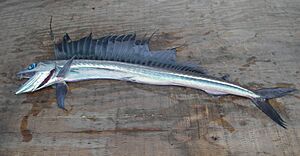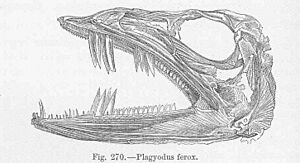Longnose lancetfish facts for kids
Quick facts for kids Longnose lancetfish |
|
|---|---|
 |
|
| Conservation status | |
| Scientific classification |
The Alepisaurus ferox, also known as the longnose lancetfish, is a fascinating deep-sea fish. It lives in the ocean depths, sometimes as far down as 1,830 meters (6,000 feet). This fish can grow quite large, reaching up to 215 centimeters (85 inches) long and weighing around 9 kilograms (20 pounds).
People sometimes call it the "cannibal fish." This is because scientists have found parts of other lancetfish inside their stomachs!
Contents
Where the Longnose Lancetfish Lives
Its Ocean Home
The longnose lancetfish lives in many parts of the world's oceans. You can find it in the Pacific Ocean, from the Aleutian Islands all the way to Chile. It also lives in the Atlantic Ocean, from the Gulf of Maine to the Gulf of Mexico. This includes the Caribbean Sea, the Indian Ocean, and the China Sea. It can even be found as far north as Russia.
These fish move up and down in the water every day. They travel from the sunlit surface waters down to the very deep, dark parts of the ocean. They do this to find their food.
Who Hunts the Lancetfish?
Even though the longnose lancetfish is a predator, it also has its own enemies. Some animals that hunt it include yellowfin tuna, opah, fur seals, Pacific cod, and salmon shark. The types of predators can change depending on where the lancetfish lives in the ocean.
Its Role in the Ocean
The longnose lancetfish plays an important part in the ocean's food web. It is both a hunter and a meal for other creatures. Studies in parts of the Pacific Ocean have shown how important this fish is. If the lancetfish were removed from these areas, it would negatively affect the ocean's balance. This shows how much this species matters to the health of the ecosystem.
What the Longnose Lancetfish Looks Like and Does
Appearance
The longnose lancetfish has a unique look. Its back fin, called the dorsal fin, has some rays that stick out strongly. It has a very large mouth with two sharp fangs. The fish is usually pale and shiny. It often has dark areas around its dorsal fin. All of its other fins are usually dark brown or black.
The lancetfish's stomach is quite special. It can store food for a long time and digest it slowly. This helps scientists learn exactly what these fish eat. Its large, sharp teeth are used for breaking apart big prey or stopping them from struggling. The teeth are not used for chewing food.
What the Lancetfish Eats
The diet of the longnose lancetfish changes depending on where it lives. They are known to eat many different types of marine animals. Sometimes, they even swallow things made by humans, like plastic!
This fish is a traveling hunter. It can dive very deep, sometimes up to 1,830 meters (6,000 feet), to find food. A study in Japan looked at the stomach contents of lancetfish that washed ashore. They found traces of animals from both the sunny surface waters and the dark deep waters. This proves that the longnose lancetfish can travel across many different ocean depths.
As mentioned, the longnose lancetfish is called the "cannibal fish" because it sometimes eats other lancetfish. How often this happens depends on how much other food is available. If there isn't much other prey, they might eat each other more often. Smaller lancetfish are less likely to eat other lancetfish than larger ones.
Reproduction and Life Cycle
Longnose lancetfish are hermaphroditic. This means they have both male and female reproductive parts at the same time. This is different from many other fish. Unlike some other hermaphroditic fish, the lancetfish has separate male and female reproductive areas.
How Humans Affect the Lancetfish
Plastic in Their Stomachs
About 30% of all longnose lancetfish have eaten plastic. Scientists often find large pieces of plastic and rope fragments in their stomachs. White and clear colored plastics seem to be eaten most often by these fish.
Caught by Accident
Longnose lancetfish are often caught by accident by fishing boats. These boats are usually trying to catch tuna using long lines. The lancetfish are not the target fish. In the Philippines, studies showed that tuna fisheries sometimes catch more lancetfish than tuna. In some areas, lancetfish make up a small percentage of all fish caught by accident. Sadly, not many lancetfish survive after being caught in these nets. Only about one-third of them live.




